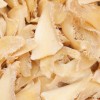Melissa Lee
This user hasn't shared any biographical information
Homepage: http://dnalc.org/about/staff/lee.html
Posts by Melissa Lee

DNA Barcoding Exposes Deregulation of Herbal Supplements
Oct 12th
Posted by Melissa Lee in DNA Barcoding
There is an increasing need for more Americans to improve their health and lifestyle. One growing trend that I see in my hometown of New York City is the building of local farms on rooftops and the increase of organic produce sections in the supermarkets. In an effort to protect our health some of us are choosing more natural and locally grown food over mass-produced, insecticide-ridden crops. And in the realm of medicine, many people are choosing more natural medicines or herbal supplements to support our health. Many common herbal medicines used today are used for a variety of reasons, More >

The flavor of extinction in a bowl of soup
Aug 27th
Posted by Melissa Lee in DNA Barcoding
The most expensive bowl of soup I have ever had in my life was a $15 bowl of ramen in the NYC restaurant Ippudo. And this was no ordinary “ramen” you would eat at home as a cash-strapped college student. This was an authentic bowl nuanced with so many rich and hearty flavors of Japanese cuisine.
Little did I know that $15 soup was considered “cheap” compared to other soups that sell for at least $100 a bowl. One such soup is shark fin soup, which is traditionally served in Chinese cuisine during special occasions. One is apt to eat this More >

DNA Barcoding Used to Detect Illegal Bushmeat at U.S. Airports
Jun 5th
Posted by Melissa Lee in DNA Barcoding
A major concern for the Centers for Disease Control and Prevention (CDC) is the association of zoonotic viruses with the importation of wildlife products. Diseases from zoonotic transmissions can spread globally and pose a threat to human health. DNA technology can be used to help identify the the types of wildlife imported and the pathogens that they carry, giving us an idea of potential health risks associated with wildlife importation.
George Amato, the director of the American Museum of Natural History’s Sackler Institute for Comparative Genomics, worked with the CDC by using DNA barcoding to identify imported bushmeat at U.S. international More >

Man versus Machine
May 7th
Posted by Melissa Lee in DNA Barcoding
Man versus machine…which one is the winner? This is definitely a question for the modern world, as people have competed with current technology, namely computers.
Are there ways the computer has out-shined the human mind? Perhaps. But I think the better question is, can computers ever catch up to our incredible brains? I don’t think so.
I was reminded of this the other day when I read an article from “Nature News” regarding an online game called, “Phylo”, created by computational biologists at McGill University in Montreal, Canada. People who played this game were able to more accurately solve problems that computers More >
Be careful what species you carry on your feet!
Mar 30th
Posted by Melissa Lee in DNA Barcoding
Have you ever considered that the one of the most diverse places on earth can be directly under your feet?
When we walk, our shoes pick up various seen and unseen organisms. Many of us walking through a field or park may be stepping on and carrying seeds from various plants. Seeds blow in the wind and also creep into the crevices of our clothes and bags. As carriers, we then transport them to new areas, making each of us essentially a seed planter. At first glance this seems like a nice job description. However, the problem lies in the fact More >
DNA in a cup of water
Jan 23rd
Posted by Melissa Lee in DNA Barcoding
In the movie, “Signs”, one of the characters, Bo, has an interesting habit of leaving half-full glasses of water lying around the house. To Bo, the water “tastes funny” after she drinks only a few sips of it. This odd habit becomes instrumental in the story’s ending. (I will not spoil it for those of you who have never watched this film!)
Incidentally, water can taste funny due to substances and/or forms of life found in it. Too bad Bo wasn’t a scientist. Perhaps she could have extracted DNA from each glass of water and found out the kinds of organisms More >
The FDA uses DNA Barcoding in the Identification of Imported Fish
Dec 19th
Posted by Melissa Lee in DNA Barcoding
One job of the US Food and Drug Administration is to ensure that all imported seafood is safe to eat and properly labelled. Accurate seafood labels are necessary for the safety of all individuals who consume such products. In 2007, toxic pufferfish were illegally imported into the United States and bypassed customary US inspection because it was mislabeled as “monkfish”. Two individuals became seriously ill after ingesting the tetrodotoxin from the pufferfish they were cooking at home.
Not only is the mislabeling of fish considered a violation of Federal law, but it can also pose a serious public health risk. Simple More >
How many species exist on Earth?
Nov 7th
Posted by Melissa Lee in DNA Barcoding
How many species exist on Earth? Well, no one really knows exactly, but there are some reasonable estimates. One figure, estimated by the Census of Marine Life Scientists, is posited to be at 8.7 million based on taxonomic methodology. Of this 8.7 million, at least 85% of the species on land and in sea still have yet to be identified and cataloged. It is amazing to think that we only know about 15% of the life found on Earth. There remains much to be discovered.
Recently, researchers at the Smithsonian used the method of DNA barcoding to identify 168 crab species More >
Got a shovel?
Oct 5th
Posted by Melissa Lee in DNA Barcoding
In the field of forensics, scientists can tell the story of how, when and where certain outdoor crimes occurred by analyzing the soil and its contents. One of its contents includes DNA. DNA from the victim or suspect can be recovered from the soil at a crime scene. In addition, DNA from other animals can be recovered in these same locations as animals slough off cells from their skin and waste.
According to a recent study in Molecular Ecology, scientists have shown that DNA fragments found in the soil can not only determine what species occupy a given area, but also More >

Welcome to the DNA Barcoding Blog!
Sep 7th
Posted by Melissa Lee in DNA Barcoding
Welcome to our new DNA barcoding blog. It truly is an exciting time to be involved in this aspect of genomic science as DNA barcoding has been used to identify new species, help explain the biodiversity of our planet and even detect food fraud. Just as a universal product code (UPC) identifies an item for sale in a store, a DNA barcode uniquely identifies each species of living thing. The DNA barcoding technique includes extraction of DNA from an organism of interest, ampliflication of this DNA through PCR (Polymerase Chain Reaction), and sequencing of the DNA at specific locations in More >
